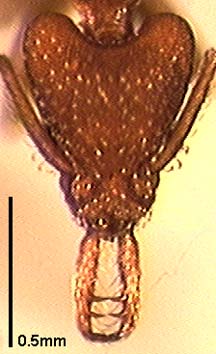Strumigenys smithii Forel 1886
Dacetini, Myrmicinae, Formicidae, Hymenoptera, Insecta, Arthropoda, Animalia
John T. Longino, The Evergreen State College, Olympia WA 98505
USA.
longinoj@evergreen.edu
22 April 1997

Specimen: Costa Rica, Prov. Heredia: La Selva Biological Station (J. Longino 3251). INBIOCRI001237601. Image by J. Longino.
Identification
Apical fork of mandible with a single intercalary tooth; mandible with two conspicuous preapical teeth; gastral dorsum smooth and shining; mandibles shorter than head; propodeal lamellae with dorsal and ventral teeth or angles (dorsal angle absent in biolleyi).
Head length 0.67-0.76mm, mandible length 0.36-0.42, CI 80-87, MI 52-61 (n=26 workers from 6 localities; Brown 1962).
In Costa Rica, smithii has a conspicuous ring of basal costulae on the gaster, these being approximately 0.10mm long on the midline. biolleyi has these costulae essentially absent or very short, less than 0.05mm on the midline. This difference is true for specimens from 28 different collections of biolleyi and 4 different collections of smithii that I have examined.
Similar species: biolleyi, godmani
Range
|

Specimen: Costa Rica, Prov. Heredia: La Selva Biological Station (J. Longino 3251). INBIOCRI001237601. Image by J. Longino. |
Costa Rica south to Santa Catarina, Brazil, and Amazonian Bolivia; St. Vincent W. I. Costa Rica: Atlantic and southern Pacific lowlands.
Natural History
Brown and Wilson (1959) summarize the genus as follows:
"Widespread in tropics and warm temperate areas. Primarily forest-dwelling; some species occur in grassland and arid scrub. ... Nests mostly in soil and rotting wood; a few species live in arboreal plant cavities in tropical rain forest. Foraging hypogaeic to epigaeic-arboreal. Food: most species are collembolan feeders; a few are polyphagous predators or occasionally feed on sugary substances..."
smithii occurs in wet forest habitats. In Costa Rica, it perhaps nests and forages in the low arboreal zone. The few collections are from that zone, and I have never observed it in Winkler samples.
Selected Records
La Selva: nest in thick dead snag, soft and rotten, extending from tree trunk.
La Selva: nocturnal foragers on low vegetation.
Braulio Carrillo National Park at 500m: prey of Neivamyrmex gibbatus.
Corcovado National Park (Sirena): nocturnal forager.
Literature Cited
Brown, W. L., Jr. 1962. The neotropical species of the ant genus Strumigenys Fr. Smith: Synopsis and keys to the species. Psyche 69:238-267.
Brown, W. L., Jr., Wilson, E. O. 1959. The evolution of the dacetine ants. Quart. Rev. Biol. 34:278-294.
 Go back to top
Go back to top

